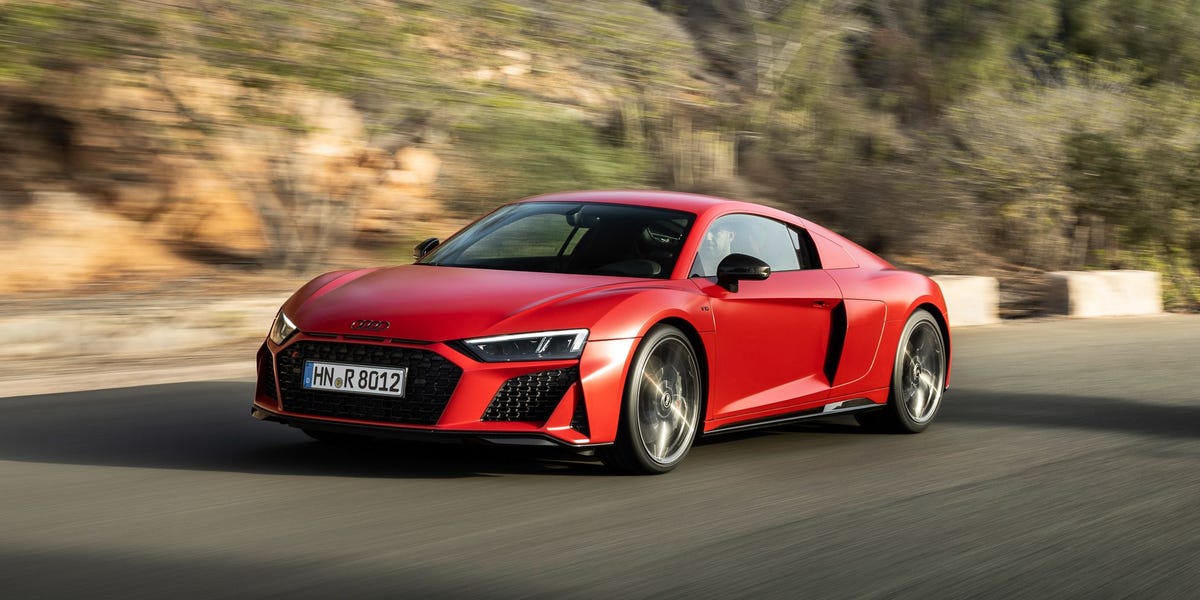Sounds a little better than a hard-working V-10? The question was raised and then answered by the combination of a motorway tunnel on the Spanish island of Gran Canaria and the 8700 rpm redline of the Audi R8 Performance Spyder, which he experienced with the roof open. The noise is both delightful and completely devoid of digital amplification – wild exhaust harmonics overlay the mechanical roar of the naturally aspirated engine, busier and edgier than a V-8, angrier than a V-12.
We’ll miss it when it’s gone, which it will be way too soon. Both the R8 and closely related Lamborghini Huracán are about to retire, and the shared V-10 engine – the last one offered in all current production vehicles – will die with them. Audi is working on a fully electric replacement for the R8, and Lamborghini is developing a hybridized twin-turbo V-8 for the successor to the Huracán. It is not yet time to write the obituary for the R8, but the reduced model range proves that the clock is ticking.
Since Audi has given up on the earlier R8 with rear-wheel drive and replaced it with the performance derivative, the R8 selection is now a binary choice: whether the drive is supplied via two or four wheels and whether the car is ordered with a fixed or fabric roof.
The new performance with rear-wheel drive differs from the Quattro not only in terms of the reduction in drive shafts. It uses a 562-horsepower version of the 5.2-liter V-10, a 30-horsepower increase over the output of the earlier RWD base, but still 40-horsepower less than its AWD sister. The two-wheel drive car dispenses with the standard carbon-ceramic brakes, 20-inch wheels, carbon sideblades and laser headlights. It is possible to correct all of these omissions with option packs, though that splits the $ 51,100 gap between the two versions.
Audi presents the RWD Performance as a more dynamic choice, although its usefulness is due in large part to cost-saving measures. Unusually for this part of the market, it rides on passive rather than adaptive dampers and delivers power to the rear wheels via a conventional limited-slip differential instead of an electronically controlled unit.
The loss of the center differential and front drive-shafts only saves a modest 110 pounds of mass, according to Audi engineers, and doesn’t change the character of the car at everyday speeds. When driving out of slower corners, the performance reaches the point of intervention of the traction control faster than the Quattro, but this intervention is inconspicuous. In comfort mode there is simply an invisible guardrail that prevents oversteering.
The selection of the more aggressive modes increases the intervention threshold and allows more slip at the rear, especially with the route-oriented performance setting that is supplied with the optional sports exhaust package. But the chassis is better in finesse than in the pure Hoonery. Even at speeds that feel mighty fast on Spanish mountain roads, the Spyder’s curve line is easier to adjust with gentle accelerator pedal inputs and shifting weight between the axles than trying to overpower the Michelin Pilot Sport 4S rear tires.
The possibility of driving an RWD Coupé on the narrow, technical race track of Maspalomas (with a spectacular view over the Atlantic) offers higher side loads, which is favored by a switch to more aggressive Michelin Pilot Sport Cup 2 tires. Safely away from public roads, the performance felt clearly relaxed under heavy pressure. This was especially true when a rain shower made the track smooth and careful acceleration became even more important – nevertheless, the R8 still felt happier when it was driven within its limits than at the edge.
The steering feel remains the weak link of the R8. Both cars we drove had the Dynamic variable-ratio rack, which will be an option in the US for $ 1400. Feedback in both is removed and muffled. The coupe was also outfitted with the intriguing option of a carbon fiber front stabilizer bar – an extra $ 1,100 that both saves 4.4 pounds of weight and improves front axle responsiveness.
Although little has changed from its previous incarnations, the V-10 remains the star feature of the R8. It lacks low torque compared to its turbocharged competitors, but it makes up for it with a strong, linear urge all the way to its high redline. As with other R8s, the performance remains subdued at lower engine speeds and radiates a completely different sound character than the always screaming Lamborghini Huracán. But as the engine speed increases, the Audi finds its voice. Long before it hits its 8700 rpm redline, the performance sounds more convincing than most supercars at any engine speed. The exhaust systems of the Euro-Spec cars were slightly dampened when they were launched on the market by gasoline particulate filters that do not come to the USA.
Whether it’s a luxury sports car or a super sports car, the R8 remains a bit unsafe and often tries to downplay the theatricality of its spectacular power unit. The RWD Performance is now the entry-level model for the range, and the starting price of $ 151,895 ($ 164,095 for the Spyder) will likely make up a larger part of its appeal than its slightly increased potential for overdriving performance. But even with a slight increase in the stickers over the old base vehicle with RWD, it still looks very cheap considering the magic inherent in this V-10 engine. We’ll surely miss it when it’s gone.
This content is created and maintained by a third party and imported onto this page to help users provide their email addresses. You may find more information on this and similar content at piano.io

